Planting Potatoes the Grow Biointensive Way
This post may contain affiliate links, which means that I may receive a commission if you make a purchase using these links. As an Amazon Associate I earn from qualifying purchases.
Grow Biointensive is an organic agricultural system that focuses on attaining greatest yields from a small garden area. The process involves double-digging beds, feeding the soil with compost, and planting closely to conserve spacing and create a microclimate. This method uses less garden space and eliminates the labor of hilling your potatoes.
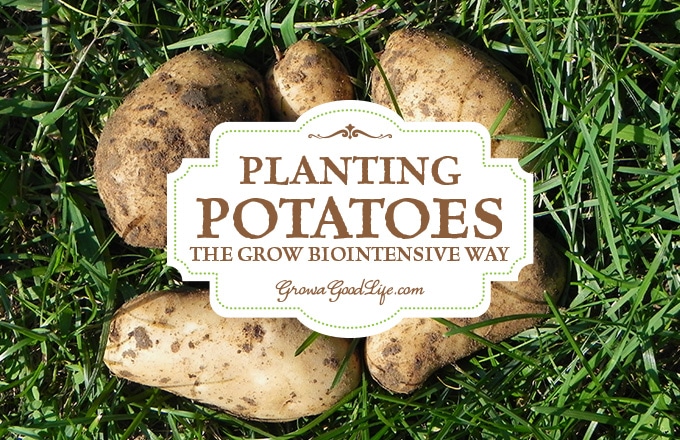
My first year of growing potatoes, I used the traditional trench method. This involves digging trenches two feet apart, mounding the soil in between the trenches, and using this soil to hill the potato plants as they grow. Although the crop was successful, I didn’t like the extra labor involved in hilling, the unkempt and messy appearance of the plot, and the wasted space in between the rows.
While I was growing my first batch of potatoes back in 2010, a fellow blogger, Laura was experimenting with John Jeavons’ Grow Biointensive potato planting method.
The Grow Biointensive program is made up of eight principles to grow healthy food naturally and care for the soil at the same time. The eight principles are: deep soil preparation, composting, intensive planting, companion planting, carbon farming, calorie farming, open-pollinated seeds, and whole system method. Learn more about Grow Biointensive.
Planting potatoes the Grow Biointensive way involves double-dug beds, feeding the soil with compost, and planting closely to conserve spacing and create a microclimate. The potato seeds are planted on top of the fluffed up soil, 9-inches apart and about 9-inches deep from the soil surface. The rows are planted in an offset, or diamond spacing. The closer spacing helps maximize space and creates a microclimate that shades out weeds and reduces moisture loss. The deep, 9-inch planting eliminates the need to hill your potatoes.
I was intrigued by this method, especially since Laura’s experiment was such a success. I did some further research and decided to try it the following year. I was so thrilled that my experiment worked even though I didn’t follow the instructions exactly! I had an abundant potato harvest that year providing plenty of potatoes for winter food storage.
I have modified the method a little over the years. Since I don’t walk on my garden beds, there is no need to double dig each year. Once your soil is loose and healthy, adding some finished compost and organic amendments at planting time is all that you will need to do. The instructions below assume you have never double dug your gardening beds.
Also See: 8 Great Tips for Growing Potatoes
How to Plant Potatoes the Biointensive Way:
Step 1: Make a measuring board:
It is helpful to use a measuring board to place across your gardening bed to mark the spacing of your planting holes. I use a 2×4 scrap board and mark out 9-inch intervals on one side with a marker, then turn the board over and mark out 9-inch intervals on the other side but off set from the first side. So all I have to do is flip the board over to measure the next row creating a diamond pattern.
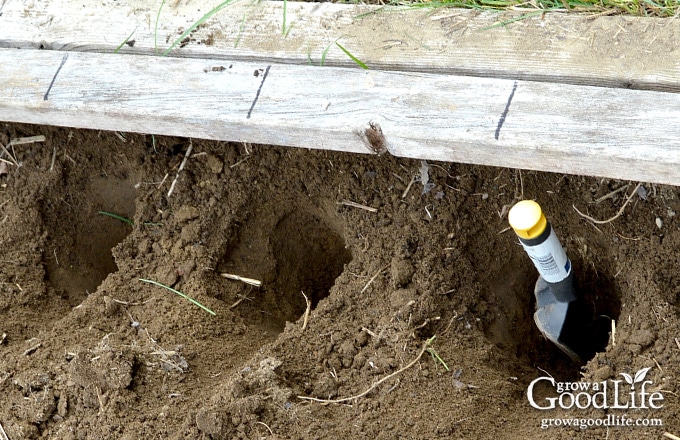
Step 2: Double dig and plant your potato bed:
You will be double digging and planting your potato seeds at the same time. The first step is digging a row about 12-inches deep. The soil from this first row is placed into a wheelbarrow and set aside. Once the row is dug, add some finished compost and an organic fertilizer to the trench. Use a digging fork to mix in the amendments and loosen the soil in the trench to a depth of another 12 inches. This will allow oxygen into the soil and helps the roots to penetrate easier.

Step 3: Plant your seed potatoes:
Place your measuring board across the bed and mark out your planting holes. You are aiming to plant your seed about 9-inches below the soil surface. Since the soil is fluffed up, you may need to dig down into the soil to be sure your planting holes are 9-inches deep. You can use a hand trowel or even a large bulb planter. Place your potato seeds into the holes along the trench with the sprouts facing up. Once the first row is planted, you will be covering it with the soil from the next row.
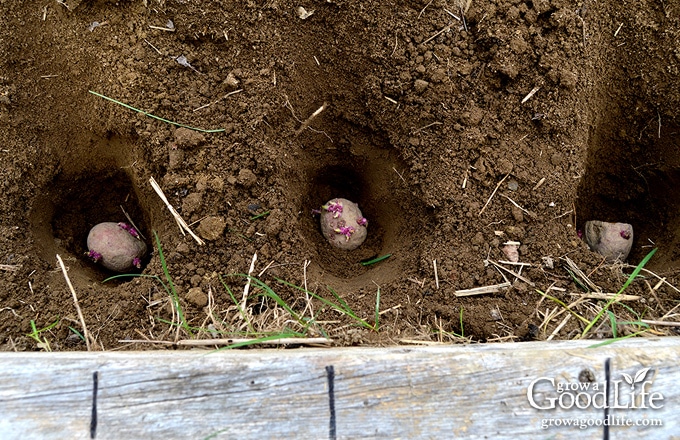
Step 4: Plant your next row:
Measure the next row 9-inches away from the first and begin digging your second row about 12-inches deep. As you dig, use the soil from the second row to cover the first. Add your amendments, mix in and loosen the soil another 12-inches with a digging fork. Flip your planting board over and plot out your planting holes. Remember, these should be spaced offset from the previous row. Continue in the same way until you have planted all your potato seed. Once you have reached the final row, cover the trench with the reserved soil from the wheelbarrow.
Step 5: Mulch the potato bed:
Once the bed is planted, string soaker hoses (if using) along the rows and water well. Mulch the bed heavily to help retain moisture, reduce weeds, and keep the light from reaching any potatoes that reach the soil surface. I like using straw as mulch, but also use shredded leaves if straw isn’t available. Your potato plants should emerge from the soil in about two weeks. It may take longer if the soil is still cold.
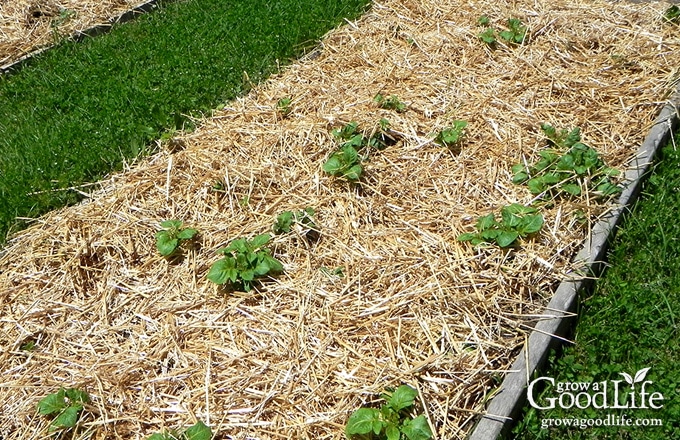
Step 6: Add poles and twine for support:
Add four poles to the corners of your potato bed and string some twine to provide support as the potato plants grow. In the book, The Sustainable Vegetable Garden, John Jeavons suggests that staking potatoes helps the plants to remain upright creating a microclimate to keep the plants and soil cooler. This will also keep the plants from flopping into the walking paths.

Step 7: Harvest your potatoes:
Baby potatoes are delicious. Once the potato plants bloom, you can begin harvesting potatoes as needed for meals. Dig carefully beneath the soil and pull out what you need. Try not to damage too many roots so the plant can continue growing. If you are growing potatoes for storage, allow the tubers to remain in the ground to mature fully.

Planting potatoes the Grow Biointensive way has served me well over the past few years so I haven’t tried too many different ways to grow potatoes, but thankfully many other bloggers have, and they allowed me to share their experiences. Check out 6 Ways to Grow Potatoes for more ideas on how to plant your potatoes.
References and Further Reading
- How to Grow More Vegetables Than You Ever Thought Possible
- The Sustainable Vegetable Garden: A Backyard Guide to Healthy Soil and Higher Yields
- Grow Biointensive Website
- A Farmer’s Mini Handbook: Grow Biointensive Sustainable Mini-Farming PDF
Want to Learn How to Grow Potatoes?
You will find everything you need to start growing potatoes in my PDF eBook, Grow a Good Life Guide to Growing Potatoes. Whether you are striving for a few gourmet fingerling potatoes or a large crop for winter food storage, this guide will show how you can grow your own, organic, homegrown potatoes.
You May Also Like:
- How to Grow Potatoes: Trench and Hill Method
- Sourcing Seed Potatoes for the Backyard Garden
- Chitting Potatoes Gives them a Head Start
- 5 Steps to Storing Potatoes for Winter
- Baked Seasoned French Fries Recipe
- Harvest Hearty Beef Stew Recipe
Good planning is key to a successful vegetable garden
Whether you are new to growing your own food or have been growing a vegetable garden for years, you will benefit from some planning each year. You will find everything you need to organize and plan your vegetable garden in my PDF eBook, Grow a Good Life Guide to Planning Your Vegetable Garden.
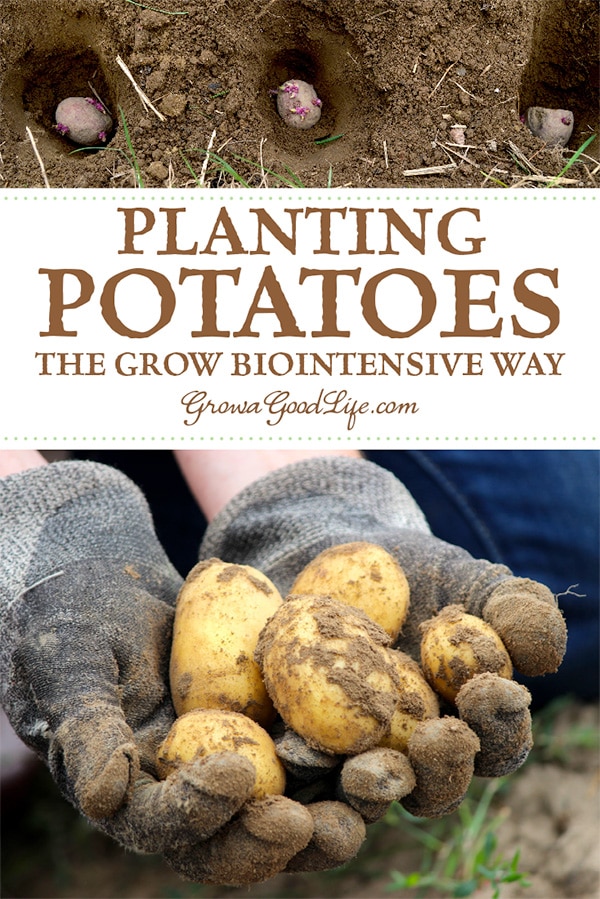


You are going to have an excellent potato patch. The extra initial work is worth it and once planted there is no further big work effort involved until it is time to harvest. I like your clever variation of using the bulb planter to drill them in!
That is so cool to plant potatoes that way, thanks for sharing!
What an interesting way to plant potatoes. I’m going to look at this gardening book.
I’ve never thought about supporting the potatoes. I’m definitely going to do that with the raised bed I have planted here at the house.
I might put some kind of support up for my potatoes too. They really do flop a lot if you don’t. And if they flop over the sides, I won’t be able to walk down the path anymore.
Sue: I am keeping my fingers crossed that the potatoes grow and do well.
Hope you have a wonderful potato harvest in your future! It’s fun to try different ways of doing things.
Allison (a tastful garden): I read the “Raising Potatoes” article in Organic Gardening as well. Last year I used the hilled rows method on p43 and had great results. However, I didn’t like the messy look and wasted space. The rows were about 2-3 feet wide to accommodate mounds of soil in between that was used for hilling as the potatoes grew. This way there is no hilling and no wasted space.
Donna: We have very heavy clay soil in this area as well. Luckily, my garden bed has been amended very well over the years. I did find some sandy soil beneath the garden while I was double digging. From what I have read on other blogs, grow bags seem to produce really well as long as they don’t dry out and rodents don’t get into the bag and have a party.
Kris: I do consider myself very lucky. The gentleman who originally built my home gardened to provide most of his food. The in-ground gardens have been amended through the years and seem to produce very well. However, they are infested with weed seeds. The only way I can grow anything without having to weed every day is with using solar mulch.
Sinfonian: I too am worried about the 9-inches of soil that the potatoes need to grow through to reach the surface. I guess we will have to wait and see 🙂
Laura (Kitsap FG): Thank you so much for sharing your experience with this method. I think I am going to be a bit anxious until I see the plants break the soil surface. I hope they grow.
The potato patch looks great and good thinking using the Mantis to reduce your work. Double digging is indeed hard work..but the beds are so improved afterwards that you benefit for years to come. My patch planted about a month ago has potato vegetation popping up all over now…so the plants are off to the races!
Very cool! I’ve abandoned my planting method despite keeping it up on my blog due to it’s popularity. If I plant potatoes again, it will be something like you do. I love how intensive you planted. I do wonder how well they’ll come up with 9 inches of soil to bust through. I can’t wait for the updates this year! Part of me wants to plant potatoes again for the variety of it.
I agree with Donna, that Maine soil makes me jealous. Nothing but good old Georgia red clay in my yard.